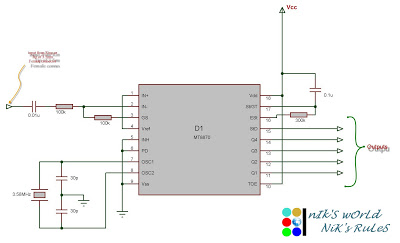
Flashing Mains Lamps circuit

This is a design for a flashlight that two 220 V alternating lights can control. The flashlight uses only one IC. IC1a IC1c to be used for the flashing signal generation. The output of IC1c thyristor T1 is controlled, it lights up then release L1. IC1c After the signal is again inverted so as L1 L2 lights not lit.
When building and the installation must be ensured that the entire circuit carries power. It is therefore recommended to the circuit board to build a real and not an experimental PCB. R1 = 220 kOhm R2 = 1 M ½ R3 = 10 M? R4, R5, R6 = 10 kOhm P1 = 100 kOhm C1, C2 = 47 uF D1-D4 = 1N4007 D5 = 5.6 V zener T1, T2 = TIC 106d IC1 = CMOS IC 4011 L1, L2 = 220 V, 250 W max lamp
The circuit design described is intended for a flashlight system capable of controlling two 220 V alternating current (AC) lamps. The primary component is a CMOS integrated circuit (IC), specifically the 4011, which is utilized for generating the flashing signal necessary to control the lamps. The circuit employs two thyristors, T1 and T2 (model TIC 106D), to manage the on/off states of the lamps L1 and L2, each rated for a maximum of 250 W at 220 V.
The configuration of the circuit includes several resistors (R1 through R6) and capacitors (C1 and C2) that work together to shape the timing and behavior of the flashing signal. Resistor R1, with a value of 220 kOhm, is likely used to limit current within the circuit, while R2, at 1 MΩ, serves a similar protective role. R3, specified as 10 MΩ, may be part of a timing network that influences the flash rate. Resistors R4, R5, and R6, each at 10 kOhm, are likely used for biasing and stability within the circuit.
The capacitors C1 and C2, both rated at 47 µF, are crucial for the timing characteristics of the flashing mechanism, storing energy to create the desired delay between flashes. Diodes D1 to D4 (1N4007) are used for rectification and protection against reverse polarity, while D5, a 5.6 V zener diode, is employed to regulate voltage within the circuit, ensuring that the IC and other components operate within their specified limits.
Installation of this circuit requires careful attention to ensure that it is built on a robust printed circuit board (PCB) rather than a prototype board, to guarantee safety and reliability when handling high voltages. Proper insulation and spacing between high-voltage components must be maintained to prevent electrical arcing or short circuits. Overall, this design provides a reliable method for controlling high-voltage lamps using a low-power control signal from the CMOS IC, suitable for applications requiring flashing light signals.This is a design for a flashlight that two 220 V alternating lights can control. The flashlight uses only one IC. IC1a IC1c to be used for the flashing signal generation. The output of IC1c thyristor T1 is controlled, it lights up then release L1. IC1c After the signal is again inverted so as L1 L2 lights not lit. When building and the installation must be ensured that the entire circuit carries power. It is therefore recommended to the circuit board to build a real and not an experimental PCB. R1 = 220 kOhm R2 = 1 M ½ R3 = 10 M? R4, R5, R6 = 10 kOhm P1 = 100 kOhm C1, C2 = 47 uF D1-D4 = 1N4007 D5 = 5.6 V zener T1, T2 = TIC 106d IC1 = CMOS IC 4011 L1, L2 = 220 V, 250 W max lamp 🔗 External reference
When building and the installation must be ensured that the entire circuit carries power. It is therefore recommended to the circuit board to build a real and not an experimental PCB. R1 = 220 kOhm R2 = 1 M ½ R3 = 10 M? R4, R5, R6 = 10 kOhm P1 = 100 kOhm C1, C2 = 47 uF D1-D4 = 1N4007 D5 = 5.6 V zener T1, T2 = TIC 106d IC1 = CMOS IC 4011 L1, L2 = 220 V, 250 W max lamp
The circuit design described is intended for a flashlight system capable of controlling two 220 V alternating current (AC) lamps. The primary component is a CMOS integrated circuit (IC), specifically the 4011, which is utilized for generating the flashing signal necessary to control the lamps. The circuit employs two thyristors, T1 and T2 (model TIC 106D), to manage the on/off states of the lamps L1 and L2, each rated for a maximum of 250 W at 220 V.
The configuration of the circuit includes several resistors (R1 through R6) and capacitors (C1 and C2) that work together to shape the timing and behavior of the flashing signal. Resistor R1, with a value of 220 kOhm, is likely used to limit current within the circuit, while R2, at 1 MΩ, serves a similar protective role. R3, specified as 10 MΩ, may be part of a timing network that influences the flash rate. Resistors R4, R5, and R6, each at 10 kOhm, are likely used for biasing and stability within the circuit.
The capacitors C1 and C2, both rated at 47 µF, are crucial for the timing characteristics of the flashing mechanism, storing energy to create the desired delay between flashes. Diodes D1 to D4 (1N4007) are used for rectification and protection against reverse polarity, while D5, a 5.6 V zener diode, is employed to regulate voltage within the circuit, ensuring that the IC and other components operate within their specified limits.
Installation of this circuit requires careful attention to ensure that it is built on a robust printed circuit board (PCB) rather than a prototype board, to guarantee safety and reliability when handling high voltages. Proper insulation and spacing between high-voltage components must be maintained to prevent electrical arcing or short circuits. Overall, this design provides a reliable method for controlling high-voltage lamps using a low-power control signal from the CMOS IC, suitable for applications requiring flashing light signals.This is a design for a flashlight that two 220 V alternating lights can control. The flashlight uses only one IC. IC1a IC1c to be used for the flashing signal generation. The output of IC1c thyristor T1 is controlled, it lights up then release L1. IC1c After the signal is again inverted so as L1 L2 lights not lit. When building and the installation must be ensured that the entire circuit carries power. It is therefore recommended to the circuit board to build a real and not an experimental PCB. R1 = 220 kOhm R2 = 1 M ½ R3 = 10 M? R4, R5, R6 = 10 kOhm P1 = 100 kOhm C1, C2 = 47 uF D1-D4 = 1N4007 D5 = 5.6 V zener T1, T2 = TIC 106d IC1 = CMOS IC 4011 L1, L2 = 220 V, 250 W max lamp 🔗 External reference





